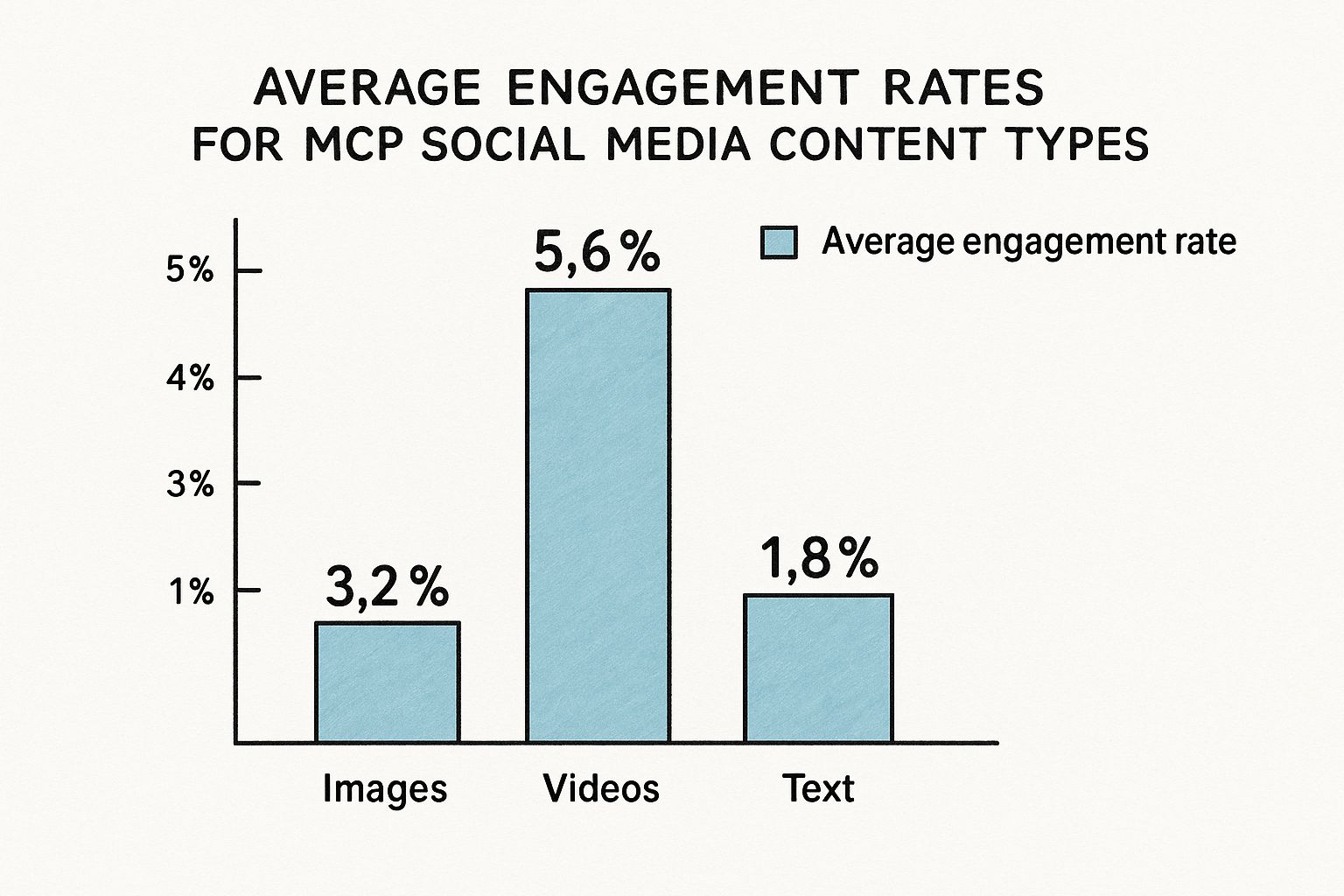Building Your MCP Social Media Foundation That Actually Works

Successfully managing social media for multiple clients (MCP social media) depends on a solid foundation. It’s more than just juggling logins. It’s about systems and strategies that consistently deliver results. Many agencies struggle, feeling overwhelmed and reacting to problems instead of proactively managing their clients’ social media presence. Thriving agencies, however, have a different approach.
The Mindset of Successful MCP Managers
Successful MCP managers know efficiency and quality go hand-in-hand. They build scalable systems from the beginning. This involves developing clear processes for everything: content creation, approvals, reporting, and client communication. These systems allow them to handle more clients without losing the personal touch. It also frees them to focus on strategy, not just daily tasks.
Key Systems for Scalable MCP Social Media
A robust MCP social media foundation needs these key systems:
- Client Onboarding: A smooth onboarding process sets the stage for success. This means clear expectations, gathering information, and setting a reporting schedule.
- Content Creation and Approval: A content calendar template ensures consistent posting and gives a framework for client feedback. Postiz, with its collaborative features, can be invaluable for managing multiple client approvals. You might also find this helpful: How to master social media editorial calendars.
- Performance Reporting: Clear reporting shows value to clients. Establish key performance indicators (KPIs) and create standardized reports to track progress and highlight wins.
- Communication Protocols: Consistent communication is essential for strong client relationships. Schedule regular check-in calls, provide performance updates, and address concerns promptly.
For example, consider managing social media for a local restaurant and a tech startup. They might both use Facebook and Instagram, but their target audiences, content, and goals are different. Effective MCP social media management means tailoring strategies while still using systematized processes. Social media is also vital for global communication and marketing. As of 2025, platforms like Facebook have roughly 3.07 billion users. Meta owns several platforms with over a billion monthly active users. This highlights the importance of these platforms for advertising and brand awareness, with over 10 million active advertisers on Meta’s platforms. More detailed statistics can be found here: Meta Statistics.
Ultimately, a successful MCP social media foundation benefits both the agency and its clients. It requires proactive planning, clear processes, and a commitment to consistent, high-quality service. This approach allows agencies to scale, keep clients happy, and achieve sustainable growth in the world of social media.
Navigating Platform Changes Without Losing Your Mind

The infographic above shows how different types of content perform on MCP social media. Video content gets the most engagement at 5.6%, followed by images at 3.2%. Text posts come in last at 1.8%. This tells us that using visual content is key for a good MCP social media strategy.
But social media is always changing. This makes things tricky for managing lots of clients, each with their own goals and audiences. Keeping up with these changes is super important for client success and agency growth. We need to be flexible to succeed.
Staying Ahead of the Curve
To do well in MCP social media, you have to be proactive. Like a ship adjusting to the wind, agencies must adapt their strategies to platform changes. Keeping an eye on industry news and announcements helps you get ready for what’s coming. It’s also smart to know a lot about different platforms and not depend on just one.
Social media is constantly evolving. TikTok has grown a lot, reaching 1.8 billion monthly active users in 2025, a 14% increase from the year before. Meanwhile, platforms like X (formerly Twitter) have seen user numbers drop, from 400 million monthly active users in 2024 to 368 million in 2025. Experts believe this is because advertisers are leaving the platform and it’s become less stable. Learn more about top social media platform usage here.
To help visualize these platform shifts, let’s look at a comparison table:
Platform Performance Comparison for MCP Management
This table compares major social media platforms, showing user growth, advertising potential, and how complex they are to manage for multiple clients.
| Platform | Monthly Active Users | Growth Rate | Ad Revenue Potential | MCP Complexity Score |
|---|---|---|---|---|
| TikTok | 1.8 Billion | 14% | High | Medium |
| X (formerly Twitter) | 368 Million | -8% | Medium | High |
| Data needed | Data needed | High | Medium | |
| Data needed | Data needed | High | Medium |
This table highlights the fluctuating landscape of social media, emphasizing the need for a diversified approach to MCP management. We can see that while TikTok is growing rapidly, X is declining. More data is needed to complete the comparison for Instagram and Facebook, but the table demonstrates the importance of considering multiple factors when choosing platforms for your clients.
Diversification and Early Warning Signs
Having clients on different platforms is a good safety net. If one platform struggles, like X did, your clients won’t be as affected. If you had also used platforms like Instagram or Facebook, the downturn wouldn’t have been so bad.
It’s also important to spot warning signs early on. If organic reach, engagement, or user feedback starts going down, it might mean a platform is losing steam. Noticing these signs and making changes quickly can protect your clients’ results. Tools like Postiz can give you the info you need to make smart choices.
Turning Change Into Opportunity
Change isn’t just something to survive; it’s a chance to grow. Agencies that adapt quickly and stay informed can take advantage of new platforms and trends. This helps them provide real value to their clients and find long-term success in the always-changing world of MCP social media.
Creating Content Systems That Scale Without Losing Soul
Generic content templates can quickly stifle engagement. But creating entirely unique content for every client isn’t sustainable when juggling multiple accounts. How do successful MCP social media managers tackle this? They create intelligent content systems that balance efficiency and authenticity.
Building a Content Framework
A content framework is like the foundation of a house. It provides structure and stability while allowing for customization. Instead of starting from scratch with each post, develop flexible templates adaptable to different clients. These templates could include:
- Post formats: Quotes, questions, behind-the-scenes glimpses, or tips
- Visual styles: Color palettes, fonts, and image filters for each brand
- Tone of voice: Formal, informal, humorous, or inspirational
This framework ensures consistency while allowing for creative variations that showcase each client’s unique brand personality.
Maintaining Distinct Brand Voices
A common concern with MCP social media is that all client content will sound the same. To address this, create detailed brand voice guidelines for each client. These guidelines should capture the brand’s essence:
- Target audience: Who are they trying to connect with?
- Key messages: What are they trying to say?
- Values: What’s important to their brand?
Referring to these guidelines helps ensure each piece of content resonates with the right audience and authentically represents the brand. Check out our guide on How to master automating social media posts for tips on optimizing automation while keeping your brand voice genuine.
Streamlining Approval Processes
Efficient approval processes are essential for scaling MCP social media. Clear communication and set timelines are key. Using a tool like Postiz with its collaborative features, can significantly streamline approvals and keep projects on track.
Content Repurposing and Quality Control
Content repurposing is another valuable strategy. A blog post can be transformed into multiple social media updates, infographics, or even short videos. This saves time and maximizes existing content’s reach. Repurposing should always add value, not just fill space. Ensure every repurposed piece is adapted to the specific platform and its audience.
Finally, establish quality control systems. This might involve a review process before posting, checklists for completeness, and tracking key performance metrics. This maintains high standards across all client accounts.
Making Data Work For You Across Multiple Clients

Many agencies struggle with data. They are either overwhelmed by the sheer volume of it or oversimplify it, losing important meaning. Smart multi-client platform (MCP) social media managers, however, know how to turn analytics into actionable insights. That’s how they drive real results for their clients.
Identifying Patterns Across Multiple Accounts
One of the biggest advantages of managing multiple social media accounts is the ability to identify larger trends. By analyzing data from various clients, you can see patterns emerge in audience behavior, content performance, and even platform changes.
This broad perspective allows you to make better decisions. You can anticipate potential challenges and capitalize on emerging opportunities. For example, if you notice organic reach declining across multiple Facebook Pages, it might signal a broader algorithm shift rather than a client-specific problem.
Creating Effective Reporting Systems
Reporting is essential for demonstrating the value of your MCP social media services. Creating individual reports for each client can be a drain on your time, though.
Successful agencies create standardized reporting templates that they can customize with client-specific data. This not only saves time, it also ensures consistency and clarity in your reporting. Tools like Postiz can help simplify this process, allowing you to pull key metrics and generate reports efficiently. This frees you up to focus on analyzing the data and providing valuable insights to your clients.
To help you track essential metrics, we’ve put together a helpful dashboard. The table below outlines key performance indicators you should be monitoring for effective multi-client platform management.
Essential MCP Social Media Metrics Dashboard
| Metric Category | Primary KPI | Secondary KPI | Reporting Frequency | Client Impact Level |
|---|---|---|---|---|
| Engagement | Reach | Likes, Comments, Shares | Weekly/Monthly | High |
| Brand Awareness | Impressions | Follower Growth | Monthly | Medium |
| Website Traffic | Click-Through Rate | Conversions | Monthly | High |
| Lead Generation | Leads | Conversion Rate | Weekly/Monthly | High |
This dashboard offers a starting point for building your own reporting system. Remember to tailor it to the specific needs and goals of each client.
Presenting Data in a Client-Friendly Way
Data is only useful if it’s understood. Clients don’t need to see complex spreadsheets. They need clear, concise summaries highlighting the key takeaways and your recommendations.
Visualizing data with charts and graphs can be very effective. Additionally, frame your analysis in terms of the client’s business goals – such as increased sales, brand awareness, or lead generation. This makes the data more relevant and actionable.
This is where storytelling comes in. By connecting the numbers to tangible outcomes, you demonstrate the real impact of your MCP social media efforts. This approach builds trust, strengthens client relationships, and ultimately drives better results.
Managing Client Relationships That Actually Last
Strong client relationships are the bedrock of any thriving MCP social media agency. Client churn can subtly damage your business, but the best managers nurture relationships that grow stronger over time. This requires a strategic communication plan, especially when managing numerous accounts.
Communication Strategies for Client Satisfaction
Even with a full client roster, each client should feel valued and understood. This begins with proactive communication. Don’t wait for them to contact you – set up regular check-in calls, even short ones, to discuss progress, address concerns, and reaffirm your dedication to their success.
A simple weekly email summarizing key performance indicators and planned social media activities can greatly increase client confidence. These updates don’t need to be long; they show you’re actively managing their account. Using a tool like Postiz to schedule and automate these updates allows more time for high-level strategy and individual client communication.
Setting Expectations and Handling Difficult Conversations
Setting clear expectations from the outset is essential. This involves defining success, outlining your services, and establishing realistic timelines. Openly discussing potential challenges and limitations helps avoid misunderstandings down the road.
Even with the best laid plans, difficult conversations are sometimes necessary. Perhaps a campaign underperformed, or a client isn’t satisfied with the content. In these situations, transparency and empathy are essential. Acknowledge the problem, explain what occurred, and outline the steps you’re taking to fix it.
Building Trust and Long-Term Partnerships
Building trust is essential for lasting client relationships in MCP social media. Consistent communication, reliable reporting, and delivering on promises all contribute to a solid foundation of trust. This builds client confidence and encourages long-term partnerships.
Also, look for ways to expand your services within existing client relationships. As you learn more about their business, you can identify areas where additional social media support would be valuable. This strategic approach to account growth strengthens your client relationships and increases client lifetime value.
Practical Tools and Techniques
Putting these strategies into action requires effective systems. Postiz, with its collaborative features, enables seamless communication between your team and your clients. You can share reports, get feedback, and manage approvals all in one platform.
- Centralized communication: Keep all client interactions in one accessible location.
- Automated reporting: Schedule regular performance reports to save time and ensure consistency.
- Feedback mechanisms: Create simple ways for clients to share feedback and suggestions.
These practical tools simplify client communication, address potential problems early on, and foster trust, leading to lasting and profitable partnerships. They also give you more time to focus on your core strength: developing effective MCP social media strategies that deliver results.
Scaling Operations Without Compromising Quality

Scaling MCP social media operations successfully takes more than simply increasing headcount. It requires careful planning and investing in systems designed for growth. This means understanding when to expand, who to hire, and how to efficiently onboard new clients, all while maintaining the high-quality service that attracted them in the first place.
Building a Scalable Team
Expanding your team is essential for scaling your MCP social media operations. But it’s not about adding just anyone; it’s about strategic hiring. Focus on roles that directly impact client results and allow existing team members to concentrate on more strategic tasks.
For example, hiring a dedicated content creator allows account managers to dedicate more time to client communication and strategy development. Bringing on a social media advertising specialist can significantly boost campaign performance and client ROI. This focused approach to team growth ensures sustainable scaling without straining resources.
Efficient Client Onboarding
As your client base grows, a streamlined onboarding process becomes critical. This involves clear communication, defined timelines, and easy-to-use tools. Postiz with its collaborative features, can simplify onboarding by centralizing information sharing and project management. This ensures a smoother transition and sets the foundation for a positive client relationship.
For improving team efficiency and organization, you might find this interesting: How to master social media scheduling with Postiz.
Technology and Training
Investing in the right technology is key for scaling MCP social media efforts. Tools that automate repetitive tasks, like scheduling and reporting, free up your team to focus on strategy and client interaction. Furthermore, standardized training programs maintain consistency in service delivery, no matter how large the team grows. This blend of technology and training provides a solid base for sustainable growth.
Maintaining Profitability While Scaling
Scaling profitably requires close attention to resource allocation and pricing models. As your operations grow, identify potential workflow bottlenecks. This could mean upgrading technology, refining internal processes, or adjusting your pricing to reflect the increasing value you offer. This proactive approach helps ensure that scaling leads to greater profits, not just increased overhead.
The Importance of the Personal Touch
While systems and automation are essential for scaling MCP social media, retaining the personal touch that attracts and retains clients is vital. Even with a larger team, ensure every client feels valued and understood. This means regular communication, personalized reporting, and a willingness to exceed expectations. By balancing efficient systems with genuine client care, you can scale your operations without sacrificing the relationships at the heart of your success.
Your MCP Social Media Action Plan
Managing your Multiple Client Projects (MCP) on social media can feel overwhelming. This action plan offers a structured approach with actionable steps you can implement right away. We’ll focus on high-impact changes, realistic timelines, and clear indicators of success.
Phase 1: Foundational Setup (Weeks 1-4)
This phase establishes the core systems for your MCP social media operations.
- Client Onboarding Checklist: Create a detailed checklist covering everything from initial consultations to gathering account access and defining campaign goals. This ensures a smooth start for new clients and establishes clear expectations. Expected Outcome: Increased client satisfaction and faster onboarding.
- Content Workflow Development: Develop standardized content workflows, including templates, approval processes, and a centralized content calendar. A tool like Postiz can be invaluable for this. Expected Outcome: Better content quality and consistency across client accounts.
- Performance Tracking Setup: Define key metrics and reporting templates tailored to each client’s goals. Set up a reporting dashboard within Postiz to streamline data analysis. Expected Outcome: Improved performance tracking and data-driven insights.
Phase 2: Content and Engagement Optimization (Weeks 5-8)
This phase focuses on refining content and increasing engagement.
- Brand Voice Refinement: Craft unique brand voice guidelines for each client. This ensures content authenticity and resonates with their target audience. Expected Outcome: Stronger brand recognition and higher engagement.
- Content Repurposing Strategy: Implement a system for repurposing content to maximize reach and efficiency. A blog post, for example, can become multiple social media updates, infographics, or even short videos. Expected Outcome: Increased content efficiency and wider audience reach.
- Community Building Activities: Develop strategies for active engagement, such as responding to comments, joining relevant conversations, and running contests. Postiz can help schedule and manage these activities. Expected Outcome: Greater community engagement and brand loyalty.
Phase 3: Scaling and Automation (Weeks 9-12)
This phase focuses on scaling operations efficiently.
- Automation Implementation: Identify repetitive tasks like scheduling posts and reporting, and automate them using Postiz. Expected Outcome: Improved team efficiency and reduced manual work.
- Team Growth and Training: Evaluate team capacity and strategically hire for roles like content creation or advertising management. Standardized training ensures consistent service delivery. Expected Outcome: Maintain high service quality and client satisfaction as you grow.
- Client Communication Enhancement: Improve communication by scheduling regular check-ins and providing proactive performance updates. Postiz facilitates streamlined communication and feedback. Expected Outcome: Stronger client relationships and better client retention.
Measuring Success and Continuous Improvement
Continuously monitor progress against key metrics throughout each phase. Track metrics like engagement rates, website traffic, lead generation, and client satisfaction. Regularly review and adjust your action plan based on the data. Postiz’s analytics dashboards make it easy to track performance and pinpoint areas for improvement. Consistent tracking, analysis, and adaptation will ensure your MCP social media strategy delivers lasting results.
Ready to streamline your MCP social media and get real results for your clients? Postiz provides a complete platform for scheduling, collaboration, automation, and performance analysis. Start your free trial today: Get started with Postiz now!





